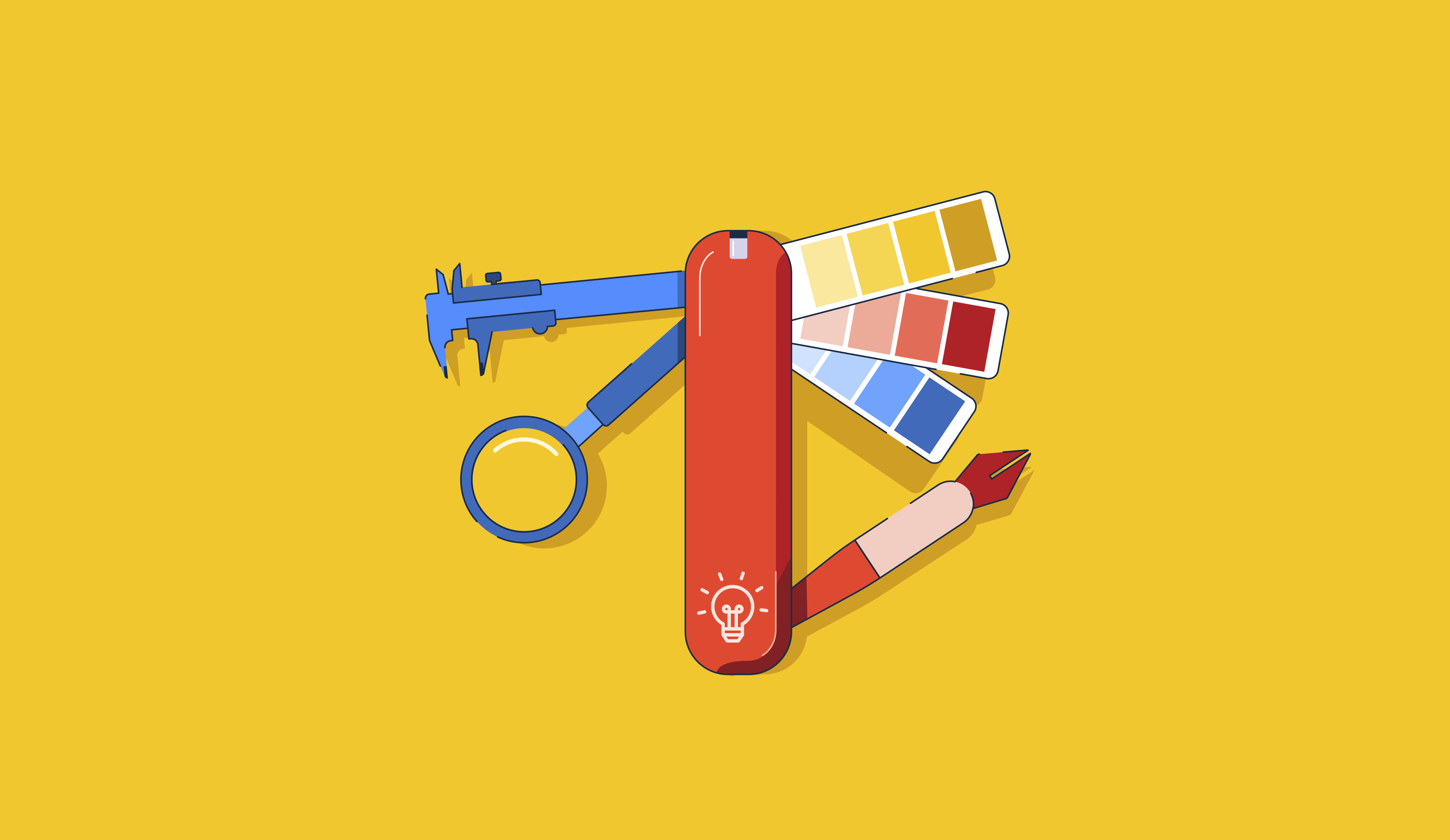It's time to reinvent problem-solving.
In recent years, there has been a shift in the way technology and business work together. Design is now at the core of most enterprise functions. But here's the catch: it isn't all about aesthetics.
Humans need help making sense of intricate business models, software integration, and breaking down complex problems. And design thinking is one way to make these interactions easy and intuitive.
Design thinking restructures how a business executes ideas, plans strategies, and solves problems by repurposing its understanding of the end users. It identifies what they need the most by highlighting problem areas and empowers employees to address the issues creatively.
Some companies use mind mapping software to optimize brainstorming sessions that align their strategies with the best design thinking models and applications.
What is design thinking?
Design thinking is a human-centered, nonlinear, and iterative process that solves complex problems with innovative solutions. It challenges businesses to let go of assumptions and rethink their understanding of their target customer base.
Regardless of your industry or role, the design thinking process is applicable on all accounts. The nature of the design thinking framework is asking relevant questions and unraveling ill-defined problems through continuous experimentation.
With better collaborations and comprehensive learning, design thinking uncovers your team’s creative potential. Its best application involves prototyping and testing possible solutions that develop better products and services. In the long run, it reduces the risk associated with new launches by breaking down buyer intent and fulfilling unmet needs.
Why is design thinking important?
There were smartphones before iPhones, cabs before Uber, social networks before Facebook, and vacuum cleaners before Dyson. So what do these companies have in common? Their unwavering fixation on delivering the best user experience (UX) out there. This is precisely why design thinking methodology can change the game for your business.
Design thinking has reshaped business mindsets to develop user-centric solutions. When you put users first, you revisit their challenges with your product and work toward improving it with maximum efficiency.
The design thinking framework doesn't guarantee superior products or creative solutions. Instead, it drives experimentation that compels design thinkers to consider user problems in a new light. Furthermore, it breaks down these complex issues into tangible actions that deliver an enhanced user experience.
Want to learn more about Mind Mapping Software? Explore Mind Mapping products.
Design thinking history
While the design thinking methodology is reasonably new, the design concept dates back to the early 1950s and 60s. During those years, architecture and engineering were the primary fields of design practitioners. But since then, scientists and businesses have spent decades trying to understand design theory, process, and practical applications.
Experts in the early 1960s applied scientific principles to make sense of design function and its influences. Around the mid-1960s, there was a new concept of “wicked problems” in the industry, depicting complex and multilayered problems.
Wicked problems became an ideal part of design thinking because they required collaboration to understand the human psyche. Horst Rittel, a German design theorist and professor, identified how to apply design thinking methodologies to solve such problems. However, he is known more for his contribution to the evolution of design theory and practice.
In 1969, cognitive scientist Herbert A. Simon first wrote about design as a way of thinking in his book The Sciences of the Artificial. Throughout the 1970s, he contributed many ideas that are now called the principles of design thinking.
Simon also examined the benefits of prototyping and testing through observation, which are now widely accepted as part of the design thinking process. The early research on artificial intelligence was also a substantial benefactor in improving the understanding of design thinking.
In the early 1980s, researchers unveiled the vision of solution-based problem-solving. Bryan Lawson, a professor in architecture, conducted a study based on the problem-solving approaches of science and architecture students.
The tests revealed that science students had a problem-focused approach, whereas architecture students had a solution-focused approach. This revelation resulted in design thinking being linked to architecture once again.
Tim Brown
Chair and co-CEO of IDEO
Over the decades, design thinking went through its set of specializations and modifications. But it was in the 1990s when IDEO, an international design and consulting firm in California, made the term design thinking and its practice famous. The company developed several toolkits and resources that made design thinking more approachable and easier to understand as a methodology, especially for those from different fields.
As a pioneer, IDEO has been practicing human-based design since the late 1970s. But the essence of design thinking lies in what it offers to the modern world. As of now, design thinking has seen around 15 years of widespread adoption and is still maturing.
Since the approach is new and part of many industries filled with lifelong learners, the design thinking framework will continue to be refined and enhanced in the years to come.
How does design thinking work?
While design thinking originated as a toolkit for designers, the process is no longer limited to one industry. From architecture to engineering to finance, this phenomenon is the go-to approach to transforming design thoughts into tangible products that focus on meeting human needs.
Design thinking works both as a multidisciplinary process and as a principle. It focuses on solving problems with practical and achievable resolutions that are people-centric.
Design thinking solutions must be:
- Desirable and appealing to users by working out best for them.
- Feasible and technologically possible to achieve within the desired timeline.
- Viable and adaptable to become a part of a sustainable business model.
Design teams (or employees in any role) practicing this tool follow steps like analysis, user research, problem discovery, creative thinking, prototyping, and testing.
Design thinking tools improve existing products with possible solutions or invent new ideas while considering market trends. It finds new ways of approaching complex issues by letting go of assumptions and encouraging people to explore ideas outside their usual thought patterns.
What is an example of design thinking?
Most of the leading companies, startups, and consultancies worldwide believe in design thinking. From Apple and Netflix to Airbnb and IBM, you’ll find design thinking at the core of these global brands' research and development processes and website UX design.
Airbnb was started in 2008 by two people who couldn't pay rent. They rented out three air mattresses with a single promise of homemade breakfast. They ended up doubling their revenue within a week.

Instead of scaling, they focused on what frugal users look for in a temporary place to stay. They delivered high-quality images of the home and listed unique features that drew users in based on their travel interests.
Similarly, Netflix became an industry giant by keeping design thinking at the foundation of its business model. At its inception, Netflix's main competitor was Blockbuster, a chain of brick-and-mortar stores renting DVDs.
Netflix eliminated the need to drive up to a store by creating a paid subscription model that delivered DVDs to the customers.
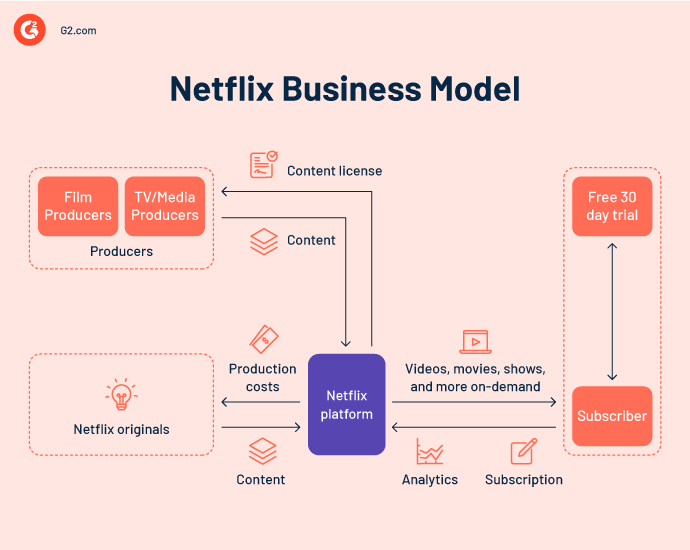
Netflix's real success came from continuous innovation. It stayed ahead of the competition by recognizing the diminishing demand for DVDs and introducing an on-demand streaming service. In 2011, Netflix used design thinking to meet the users' need for original content that wasn't streaming on traditional networks.
This is what design thinking is all about: understanding your end users by empathizing with them and continuously innovating new ideas to deliver a unique experience.
Key concepts of design thinking
As a business looking to implement design thinking methodologies to your work model, it's crucial to understand the three concepts, also known as the 3 Es of design thinking: empathy, expansive thinking, and experimentation.
Empathy
Building products at the edge of innovation is incredible. But the innovation process isn’t effortless. If you’re building products based on assumptions without solving anyone's problems, it's time to revise your strategy.
Empathy lies at the crux of design thinking because it pushes businesses to look at what people need. It encourages them to empathize and learn from their target users' needs and motivations. This continuous process of understanding your customers creates meaningful products that solve critical issues.
Expansive thinking
Once you stop operating on assumptions, you can grow your team’s creative capabilities by focusing on expansive thinking or brainstorming.
The design thinking framework encourages people to shift their focus from discovering the perfect solution to rethinking the problem from every imaginable angle. Because sometimes, all you need for big ideas to come through is to break the cycle and change what you were looking for.
Experimentation
Not every idea on your list will be a hit or resonate with the target user. So it’s vital to put your design thoughts through multiple rounds of testing before the official launch.
Experimentation primarily focuses on creating a prototype of your idea and testing it on a small group of people. The collected data and feedback from this experiment will help decide whether you need to tweak or discard the product.
31%
consumers feel that an engaging user experience should be a company’s primary focus when designing a website.
Source: MarTech Series
The 5 stages of design thinking
The design process might appear linear, but it’s iterative in nature. Particularly in the later stages of prototyping and testing, it can take a few hit-and-miss approaches before you invent the perfect product.
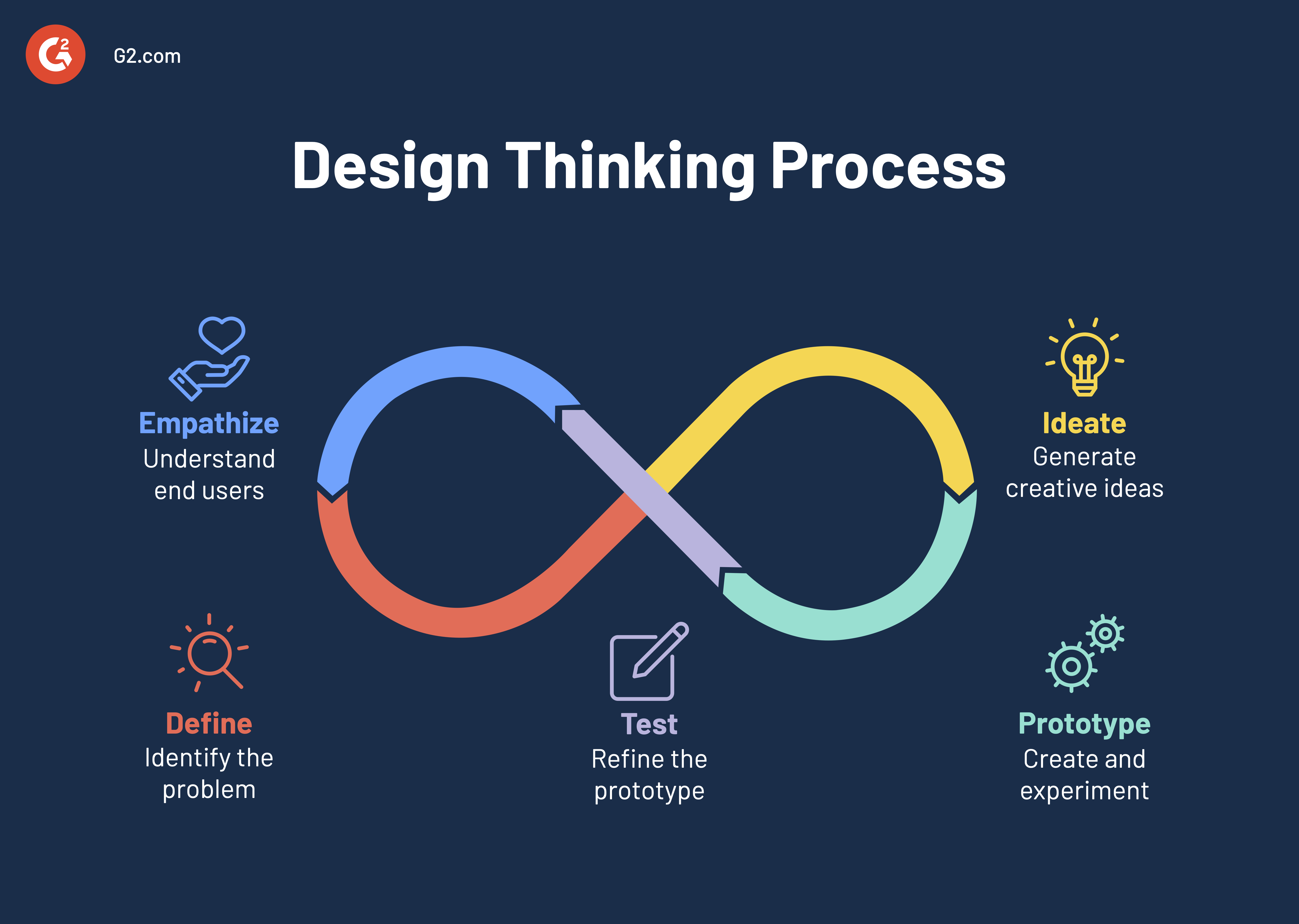
Following the design thinking steps can take you from a blank canvas to a state-of-the-art invention that generates groundbreaking solutions. Design thinking models can have anywhere from three to seven stages, depending on what works best for your business. However, the most widely practiced design thinking model involves these five stages:
- Empathize. Understanding your customer base is the first step in creating products that match their wants and needs. Gather user insights by practicing empathy, observation, and letting go of assumptions.
- Define. After getting to know your customers, the next step is to define the problem you want to solve. This stage determines the rest of the design thinking process. Consolidating user needs gives you specific, human-centered design thoughts that you can achieve with creative thinking.
- Ideate. Once you have identified the problem statement, it's time to brainstorm ideas. Design thinking promotes rethinking the problem from multiple standpoints. By focusing on the number of ideas and not the quality, you might stumble upon something groundbreaking.
- Prototype. With a list of narrowed-down ideas, you can now work on experimenting with new product concepts. The type of prototype depends on what you’re building. Many companies use prototyping software to set a clear vision and practice rapid tests that prevent costly mistakes.
- Test. This stage involves testing the prototype on a small number of users and getting insightful feedback based on their interactions. It identifies which aspects of the prototype work, what needs modifications, and if it should move forward.
Since design thinking is nonlinear and iterative, businesses can implement these stages in any order. The phases can be parallel or repetitive because design thinking aims to create dynamic approaches to get work done.
Crafting a design thinking model while keeping these steps in mind is a great way to align your team on what needs action now and what to follow next.
What are the 4 Ps of design thinking?
Each element in the design thinking framework is vital to the process and cannot be separated from others.
- Person: The traits, behavior, and attributes of a creative person
- Process: Multiple stages of how a person conducts creative thinking
- Press: The environment around a person that encourages creativity
- Product: The outcome of creative design thinking and what makes it creative
How is mind mapping used in design thinking?
When we experience something new, our brain immediately connects it with similar memories. These connections spread like tree branches and join the current topic with multiple related experiences. This process of linking associated ideas with a central element is how mind mapping works.
Mind mapping is a critical tool for the design thinking processes. It helps visualize, classify, and structure an idea, to track patterns and trends over time. The collected insights of mind mapping are beneficial before the prototype and testing stages are carried out.
For many of us, images stay in our minds longer than other forms of information. This is just one of the reasons why mind maps are effective. They take advantage of the tendencies of our minds to think visually and understand a subject by creating links.
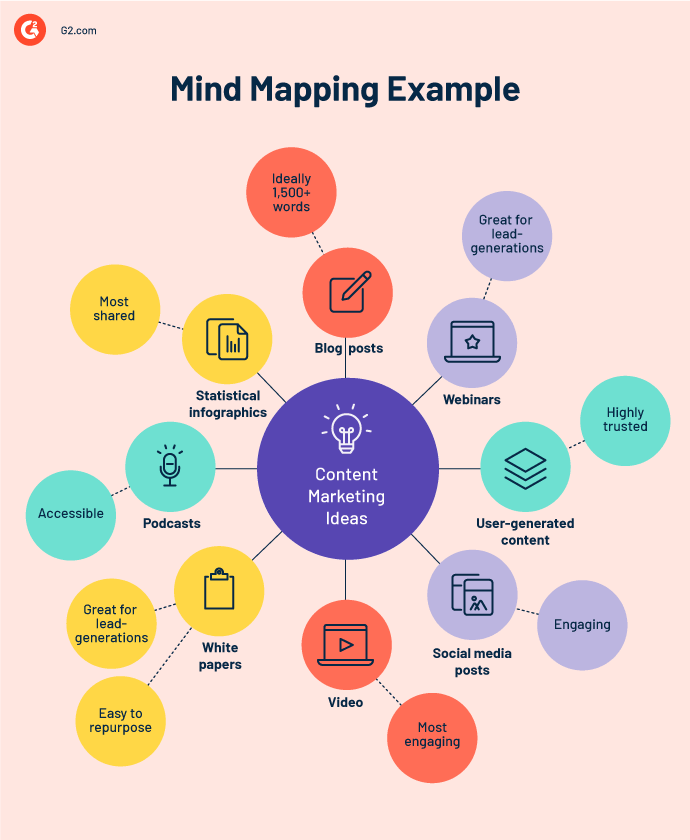
Once you introduce a design idea, your team members may or may not have a vague notion of what it should look like and how it should perform. Mind mapping helps clarify how that idea will execute into a functional product. It can organize design thoughts and make complex systems understandable.
For instance, if you’re designing an app, a mind map can explore what the interface will look like, what features the app will bring, and how those will interact.
The 4 principles of design thinking
The four design thinking principles were written by Christoph Meinel and Larry Leifer of the Hasso-Plattner Institute of Design (d.school) at Stanford University.
- The human rule: A design must focus on ideating user-centric solutions that meet human needs.
- The ambiguity rule: Break free from preconceived notions, let go of the urge to control problems and experiment with more creative freedom.
- The redesign rule: Understand the evolution of technology in meeting human needs in the past and redesign for the future.
- The tangibility rule: Tangible ideas bring concrete feedback and improvement points, and prototyping is the best way to gain these insights.
Design thinking vs. human-centered design
In the world of design and product development, design thinking and human-centered design go hand in hand to create unique solutions. So the question isn't which one is better but how to implement either at different stages of product design.
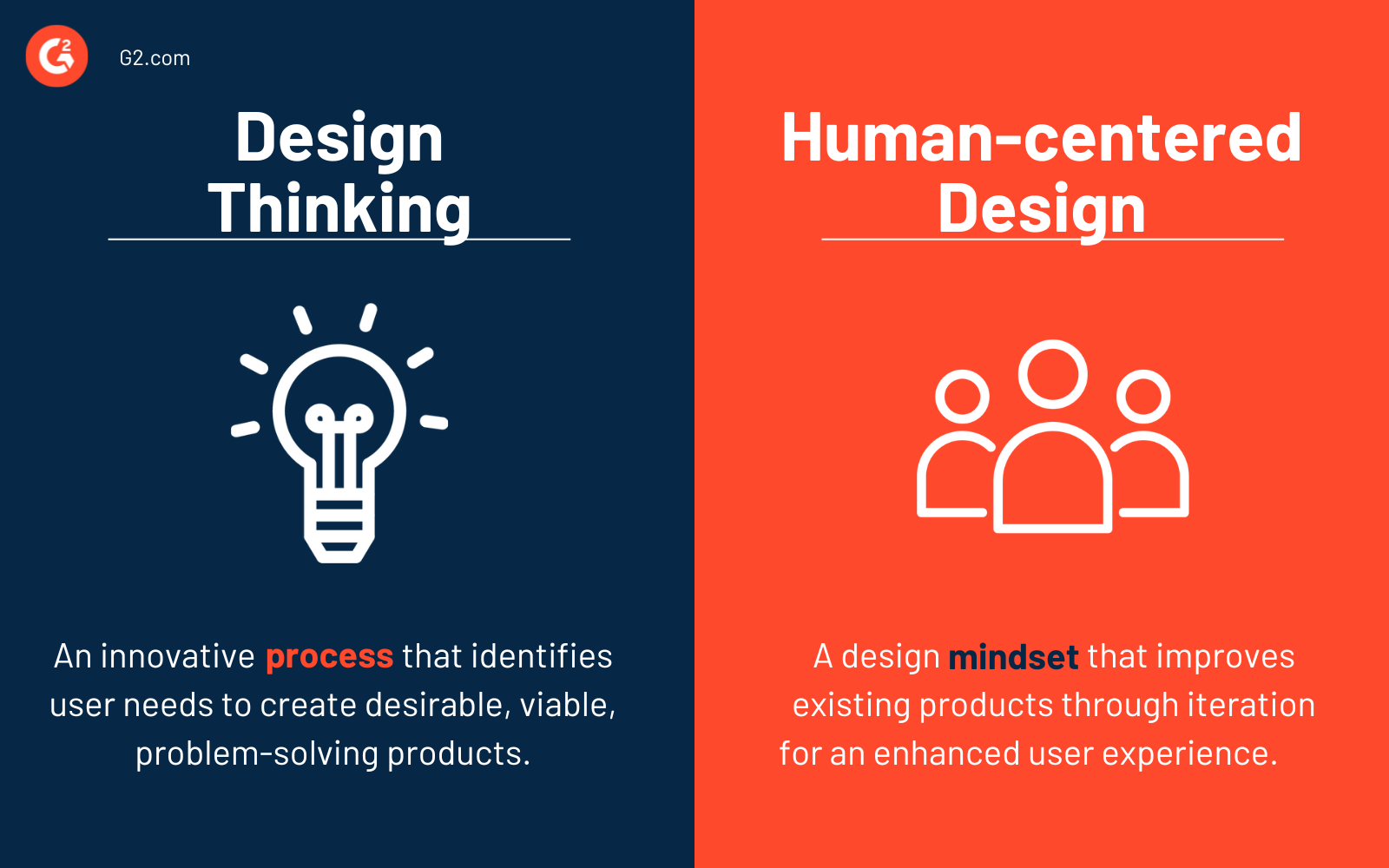
Design thinking is a process. It takes the big picture while focusing on innovation and creative problem-solving. It assesses user needs and checks the viability and feasibility of developing a product that meets those needs.
Human-centered design is a mindset. It focuses on the details and creates solutions to improve a product’s user experience. While design thinking is the toolkit for working with something new, human-centered design is the perspective you need to tweak that product through iteration.
For instance, design thinking can disclose the target users' behavior and lead you to your prototype. A human-centered design mindset gathers feedback and uses it to improve that prototype. It helps you build the final product that solves real-world problems while providing the best experience.
Design thinking vs. systems thinking
Design thinking and systems thinking don't have much of a connection. It's a simple case of synthesis vs. analysis.
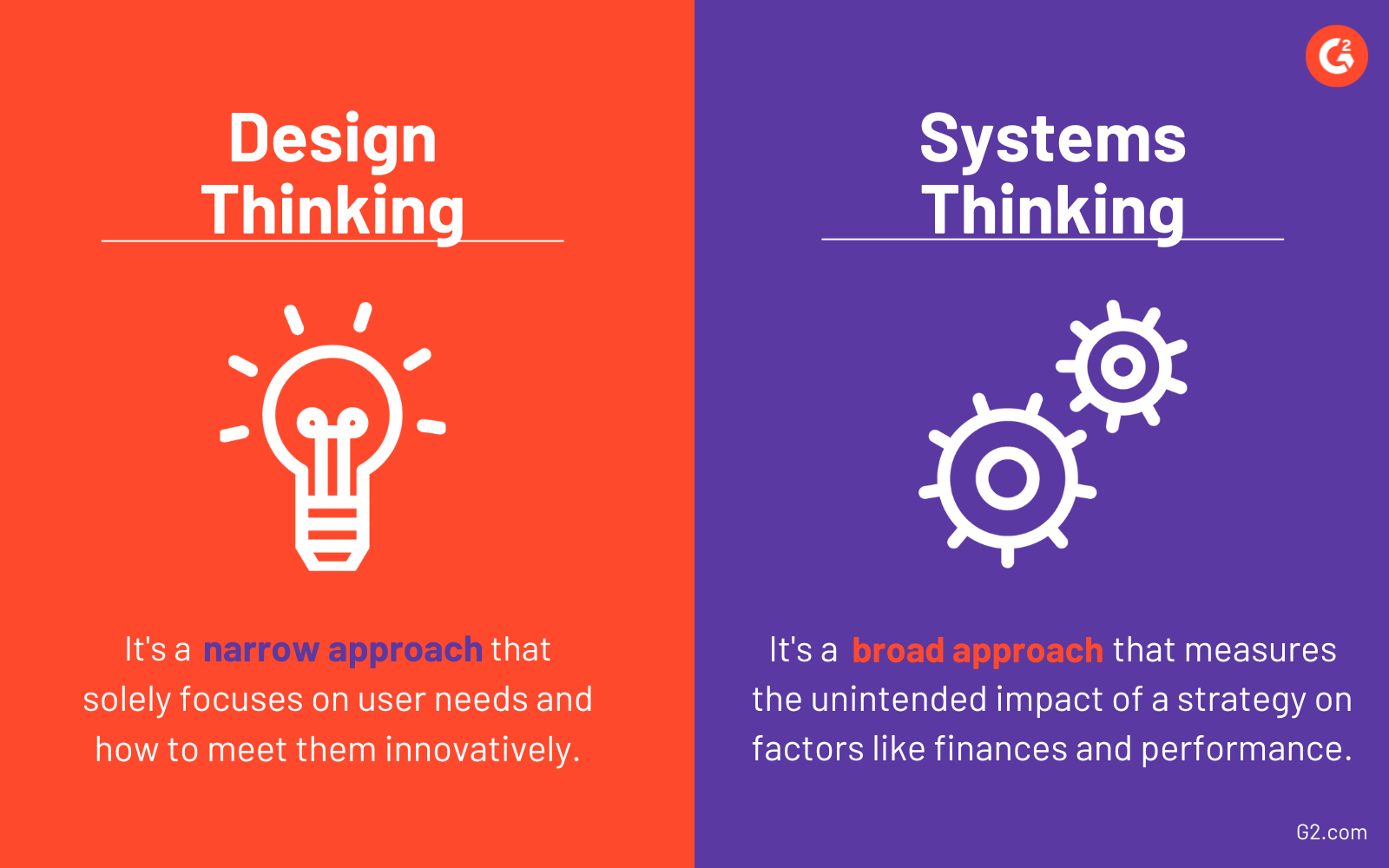
The design thinking approach is only concerned with locating users' needs. It creates solutions that bring value to the overall experience. Systems thinking is a holistic approach that observes the unintended impact of a strategy; how it affects your finances, competition, brand, and performance.
As automation and machine learning software transform healthcare, communication, and transportation, the need for human-focused strategies is higher than ever. Tools like design thinking and systems thinking help businesses reframe their strategy correctly.
Design thinking benefits
Design thinking breaks the barriers of traditional business approaches by giving employees at all levels the freedom to explore ideas, collaborate, and solve problems. Design thinking also:
- Promotes innovation. The iterative nature of design thinking pushes practitioners to chase innovative strategies and solves ill-defined problems that didn’t have a solution before.
- Views challenges in a new light. Unlike linear thinking, the design thinking framework encourages revisiting challenges from every aspect. Businesses become people-focused instead of problem-focused, discovering unique ways to find solutions.
- Celebrates creative experimentation. By developing prototypes and gathering instant feedback, design thinking uplifts creative experimentation. This leads to breakthroughs and saves bad investments in time, money, and resources.
- Adapts to business models universally. The design thinking methodology is universally adaptable. Its application has a positive effect on all business models, from customer service to product development.
- Fosters cross-functional collaboration. The design thinking process involves employees across departments. These collaborations include feedback, brainstorming sessions, or exploring diverse perspectives to tackle a problem.
Design thinking challenges
No matter how unique your strategy is, every design concept comes with its set of challenges. Some of the most common ones include:
- Perfectionism. Since design thinking models are iterative, businesses often get hung up on the idea of a perfect product. But all they really need to focus on is launching a minimally viable product (MVP) during the prototype stage and enhancing it as per customer feedback.
- Attachment to prototype. Building and testing prototypes take a lot of time. This often means stakeholders grow too invested in their prototype, despite failed tests. They refuse to see that if it's not serving the users, it doesn’t do what it's supposed to do.
- Short-term thinking. Making design thinking a part of one product or project is not enough because it is not a short-term solution. Companies must tweak their entire ecosystem to become consumer-oriented and include design thinking in their long-term strategy.
- Lack of human input. Understanding user perspective doesn’t happen overnight. Businesses often fail to include human input and collaboration as part of their design thinking process, resulting in inefficient problem-solving.
Design thinking best practices
The hardest part of design thinking is taking the first step, so it's essential to keep these best practices in mind before you go hands-on with the process.
- Establish an open environment for collaboration. Brainstorming sessions are intimidating. Nobody wants to present an idea only to get judged for their contribution. Therefore, businesses need to develop an open and judgment-free collaborative setup where people don't hold back from participating.
- Always research your competitors. Never underestimate the power of competitor analysis. Look into what those companies are doing – are they facing the same problems as you are? Did they test out solutions that are in your pipeline? What was their outcome? What can you do to make your product the most viable?
- Focus on learning at every stage. Design thinking is not linear, but you can learn new things at every step by practicing empathy and reevaluating problems with a user-centered design approach. Your findings help you ask the right questions, resulting in innovative solutions.
- Test several brainstorming tools. The brainstorming process differs depending on which tools you use. Test several techniques to identify which one is the most rewarding for your collaborative efforts. Don't restrict yourself because what works well for one strategy might not be effective for another.
- Have a clear vision before prototyping: Stakeholders must identify which ideas they want to test before entering the prototype stage. Building the right experience to solve critical problems isn’t possible without a clear vision. And juggling multiple ideas only makes it difficult to gather relevant user feedback.
Don't break bad - break out of the box!
Incorporating the design thinking framework into your business strategy is perfect for breaking through productivity barriers, overcoming problems with out-of-the-box solutions, and creating truly innovative user experiences.
If you want to experiment with the visual elements of design thinking, take a moment to explore the best design software and tools that digitize the creation process seamlessly.
Washija Kazim
Washija Kazim is a Sr. Content Marketing Specialist at G2 focused on creating actionable SaaS content for IT management and infrastructure needs. With a professional degree in business administration, she specializes in subjects like business logic, impact analysis, data lifecycle management, and cryptocurrency. In her spare time, she can be found buried nose-deep in a book, lost in her favorite cinematic world, or planning her next trip to the mountains.
